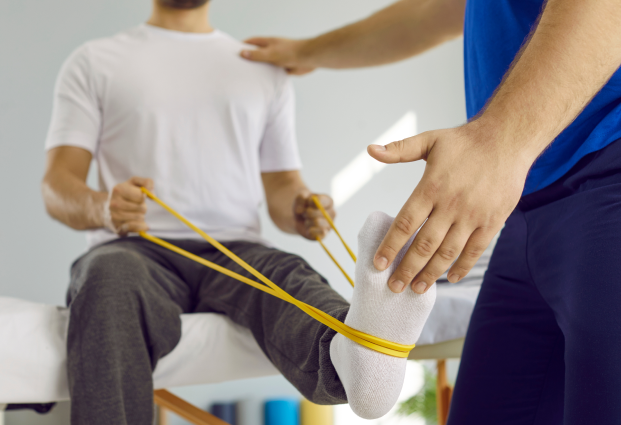Symptoms:
- Joint Pain: Persistent discomfort in one or more joints, often worsened with movement.
- Swelling: Inflammation leading to swelling around affected joints.
- Stiffness: Reduced range of motion, especially after periods of inactivity.
- Redness and Warmth: Increased blood flow to affected joints may result in redness and warmth to the touch.
- Fatigue: Generalized tiredness or exhaustion, commonly associated with inflammatory types of arthritis.
Prevention:
- Regular Exercise: Engaging in low-impact exercises to strengthen muscles and maintain joint flexibility.
- Maintain Healthy Weight: Excess weight increases stress on weight-bearing joints; maintaining a healthy weight can alleviate strain.
- Balanced Diet: Consuming a diet rich in anti-inflammatory foods, such as fruits, vegetables, and omega-3 fatty acids.
- Joint Protection: Using proper techniques during activities to minimize joint stress.
- Avoiding Smoking: Smoking has been linked to an increased risk of developing rheumatoid arthritis; quitting can reduce this risk.
Treatment:
- Medications: Nonsteroidal anti-inflammatory drugs (NSAIDs), corticosteroids, or disease-modifying antirheumatic drugs (DMARDs) to manage pain and inflammation.
- Physical Therapy: Exercises and techniques to improve joint function, strengthen muscles, and enhance overall mobility.
- Occupational Therapy: Techniques to adapt daily activities and improve joint function.
- Lifestyle Modifications: Heat or cold therapy, joint protection techniques, and assistive devices to ease symptoms.
- Surgery: In severe cases, joint replacement surgery may be considered.
- Biological Therapies: Targeted medications that modify the body's immune response in autoimmune forms of arthritis.
- Alternative Therapies: Acupuncture, massage, or dietary supplements may offer relief for some individuals.
Arthritis, a widespread medical condition, encompasses a group of disorders characterized by inflammation and stiffness in the joints, leading to pain and decreased mobility. There are various forms of arthritis, with osteoarthritis and rheumatoid arthritis being the most prevalent. Osteoarthritis results from the wear and tear of joint cartilage over time, while rheumatoid arthritis is an autoimmune disorder where the immune system mistakenly attacks the joints. Symptoms often include joint pain, swelling, and difficulty moving the affected areas. Arthritis can impact people of all ages and backgrounds, affecting daily activities and overall quality of life.
Symptoms:
- Joint Pain: Gradual onset of pain, typically worsening with movement and alleviated with rest.
- Stiffness: Reduced flexibility and increased stiffness, particularly after periods of inactivity or upon waking.
- Swelling: Inflammation around affected joints, leading to mild swelling.
- Grating Sensation: A feeling of grating or grinding within the joint during movement.
- Joint Enlargement: Formation of bony spurs and joint enlargement in advanced stages.
Prevention:
- Maintain Healthy Weight: Reducing excess body weight to alleviate stress on weight-bearing joints.
- Regular Exercise: Engaging in low-impact exercises to strengthen muscles and maintain joint flexibility.
- Joint Protection: Using proper techniques during activities to minimize joint stress.
- Balanced Diet: Consuming a diet rich in nutrients, including calcium and vitamin D, for joint health.
- Avoiding Joint Injury: Taking precautions to prevent joint injuries that may contribute to osteoarthritis development.
Treatment:
- Pain Medications: Over-the-counter or prescription pain relievers to manage discomfort.
- Physical Therapy: Exercises and stretches to improve joint flexibility, strength, and function.
- Lifestyle Modifications: Heat or cold therapy, joint protection techniques, and assistive devices to ease symptoms.
- Topical Pain Relievers: Creams, gels, or patches applied directly to the skin to alleviate pain.
- Injections: Corticosteroid or hyaluronic acid injections to reduce inflammation and provide relief.
- Surgical Intervention: Joint replacement surgery for severe cases, where damaged joints are replaced with artificial ones.
- Weight Management: Maintaining a healthy weight to reduce stress on joints.
- Joint Supplements: Some individuals find relief with supplements like glucosamine and chondroitin.
Osteoarthritis, the most common form of arthritis, is a degenerative joint disorder characterized by the gradual breakdown of joint cartilage. This essential cushioning tissue between bones wears away over time, leading to pain, swelling, and impaired joint function. Osteoarthritis typically affects weight-bearing joints such as the knees, hips, and spine, and it often develops with age or as a result of joint injury and overuse. Individuals with osteoarthritis may experience stiffness and discomfort, particularly after periods of inactivity.
Symptoms:
- Pain: Ranging from dull aches to sharp, intense pain, often exacerbated by movement.
- Swelling: Inflammation around the knee joint, leading to visible swelling.
- Stiffness: Reduced flexibility and ease of movement in the knee.
- Grinding Sensation: A feeling of grinding, popping, or cracking during joint motion.
- Instability: Difficulty maintaining balance or a sense of unsteadiness in the affected knee.
Prevention:
- Maintain Healthy Weight: Reducing excess body weight to minimize stress on the knee joints.
- Regular Exercise: Strengthening the muscles around the knee through targeted exercises.
- Proper Footwear: Wearing supportive shoes to provide adequate cushioning and stability.
- Avoiding Overuse: Employing proper techniques and avoiding excessive strain during physical activities.
- Warm-up and Stretching: Incorporating a proper warm-up and stretching routine before engaging in physical activities.
Treatment:
- Rest and Ice: Allowing the knee to rest and applying ice to reduce inflammation.
- Pain Medications: Over-the-counter or prescription pain relievers to manage discomfort.
- Physical Therapy: Exercises and stretches to improve knee strength, flexibility, and overall function.
- Bracing or Supportive Devices: Using knee braces or supports for stability and protection.
- Injections: Corticosteroid injections for inflammation reduction.
- Surgical Intervention: In cases of severe injury or conditions like torn ligaments or advanced osteoarthritis.
- Lifestyle Modifications: Adjustments to activities and daily routines to minimize stress on the knees.
- Joint Supplements: Some individuals find relief with supplements containing glucosamine and chondroitin sulfate.
Knee pain is a common discomfort that can affect individuals of all ages, often stemming from various causes such as injury, overuse, or underlying medical conditions. The knee, a complex joint central to everyday activities, may experience pain due to factors like ligament tears, osteoarthritis, or inflammation. This discomfort can range from mild to severe, hindering mobility and impacting overall quality of life. Knee pain may present with symptoms like swelling, stiffness, or a grinding sensation during movement.












